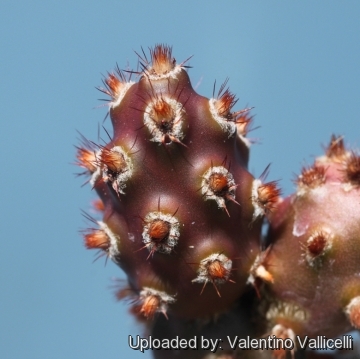Accepted Scientific Name: Tephrocactus molinensis
Cactus (Paris) no. 38: 249. 1953; cf. Gray Herb. Card Cat.

Tephrocactus molinensis cv. Purple Body Photo by: Valentino Vallicelli
Origin and Habitat: Argentina (Province of Salta: Questa de Molinas in the valle Calchaquí)
Habitat: Grows on sandy soils in a open area among wide spread Trichocereus pasacanaSN|6864]]SN|6864]].
Notes: At the end of the dry season the cladodes are very dehidrated and plants retract almost at soil level.
Synonyms:
See all synonyms of Tephrocactus molinensis
back
Accepted name in llifle Database:Tephrocactus molinensis (Speg.) Backeb.Cactus (Paris) no. 38: 249. 1953; cf. Gray Herb. Card Cat.Synonymy: 8
Cultivars
(2):
back
Description: It is a small segmented succulent that grows into mounds of tiny stems or joints. In cultivation grows as a small erect segment chains. In habitat the plants stay smaller because the uppermost segments are detachable and drop easily.
Purple Body form: The special feature of this clone is that the young clatodes are of a very odd vine red colour.
Segments: Bronze-red to dark magenta turning grey-green the year later, globose to ovoid, up to 2.5 cm long and wide (but up to 4 cm long or more in cultivation), fragile, spineless with dense glochids. The tubercles are somehow raised but not sharply delimited.
Areoles: 20-25, extending to base, relatively large with white felt and conspicuous tufts of reddish-brown glochids not easily detachable. A particularity of this plant is that it seems to be able to completely regrow all the glochids even on old corky basal segments, so the tufts of glochids get denser and denser as the stems age.
Spines: Spineless.
Flower: Up to 3 cm long, dirty white or very pale pink a little hyaline with darker midrib, a green centre and green filaments. Pericarp is comparatively small and has areoles furnished with wool and bristle-like glochids as strong as the one on the young shoots.
Fruit: Dry, thin walled.Small clumping segmented succulent, In cultivation grows as a small erect segment chains. In habitat the plants stay smaller because the uppermost segments are detachable and drop easily.
Areoles: Very ornamental with bright yellow-brown glochids and white felt.
Spines: Spineless.
Flower: Dirty white or very pale pink a little hyaline with a green centre and green filaments. Pericarp is comparatively small and has areoles furnished with bristle-like spines as strong as the one on the young shoots.
Subspecies, varieties, forms and cultivars of plants belonging to the Tephrocactus molinensis group
 Tephrocactus molinensis cv. Purple Body Photo by: Valentino Vallicelli
Tephrocactus molinensis cv. Purple Body Photo by: Valentino VallicelliSend a photo of this plant.The gallery now contains thousands of pictures, however it is possible to do even more. We are, of course, seeking photos of species not yet shown in the gallery but not only that, we are also looking for better pictures than those already present.
Read More... Cultivation and Propagation: [[It is easy to grow but usually couldn’t get very tall as segment kept falling apart. It is fairly cold resistant and hardy to -9°C depending on the clone, Need full sun, (with insufficient illumination stems get thinner as a result of the lack of sun) The main growing period is spring. It might produce some new segments in the autumn too. Needs good drainage. Propagation is through segment cuttings, or occasionally seeds The little glochids at the base of these larger spines are quite a nuisance, and it is best to use gloves to handle this plant.
Propagation: Cuttings. It suckers profusely and is very easy to grow by just knocking off one of the 'cones' and stuffing it in the ground.











